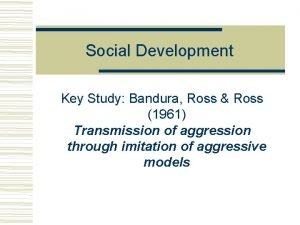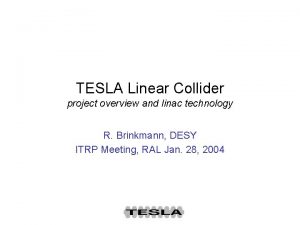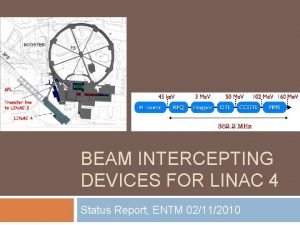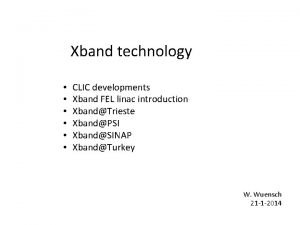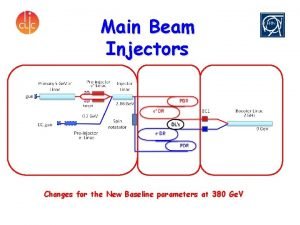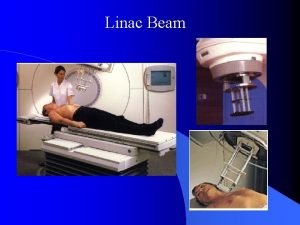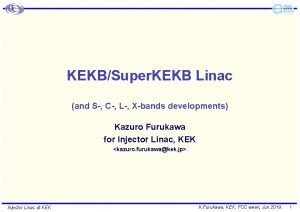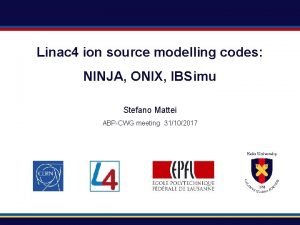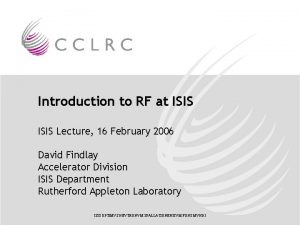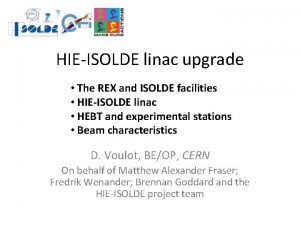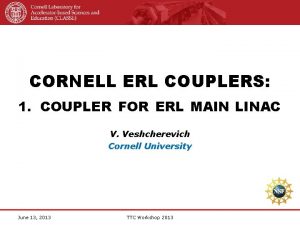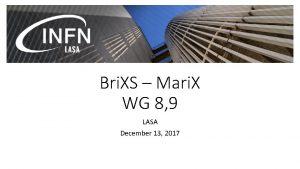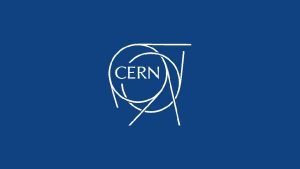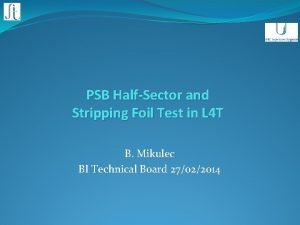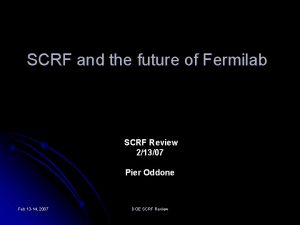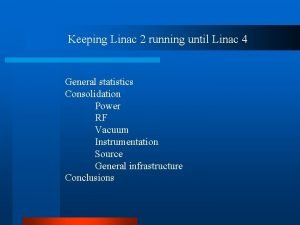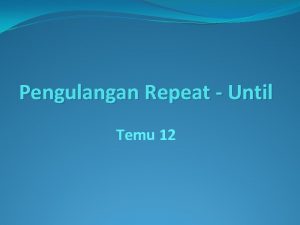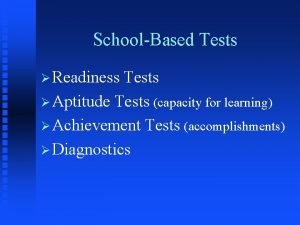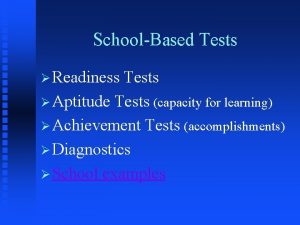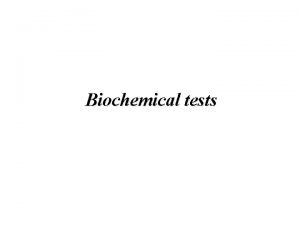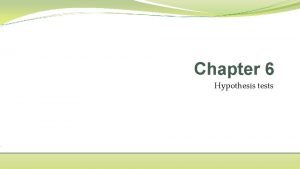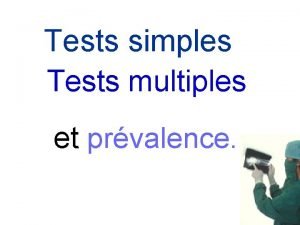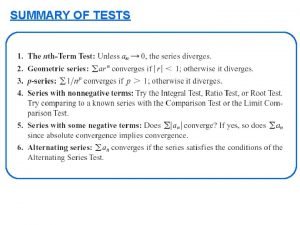SCRF Linac Systems Tests M Ross Until the














- Slides: 14

SCRF Linac Systems Tests M. Ross “… Until the lay of the land is settled by further data from the LHC, all plans for future colliders are in suspended animation. ” Director’s Corner, 2011 -10 -11 But R & D on future lepton colliders is quite alive, even thriving, and each one of us should consider what constitutes an adequate systems test… ILC SCRF systems testing will be done at Fermilab - NML. ILC linac tests compatible with Fermilab high intensity program. What is the plan and strategy? 2011 -10 -28 Planning/Strategy Workshop (Marc Ross - Fermilab) 1

Ge. V-class pulsed linacs based on TESLA technology: • TTF (2001) 250 Me. V; 17 cavities – Demonstrated full current, stable acceleration • SNS (2006) 1 Ge. V; 81 cavities – 98% SC linac availability • FLASH (2005) 1. 2 Ge. V; 56 cavities • 9 m. A demonstrations (2008 -) • KEK-STF (2013 -) ~ 16 cavities • NML (2012 -) ~ 48 high gradient cavities • EU-XFEL (2014) - 800 cavities 2011 -10 -28 Planning/Strategy Workshop 2

ILC Linac • Linac to provide 250 Ge. V mono-energetic, long-term stable, high power beams, reliably, with minimum cost. Components: • HLRF Source • Power Distribution • Cavity/CM • “Beam” • Controls • Utilities 2011 -10 -28 Cost Drivers: • Gradient • Cryogenics • Electricity/Cooling • RF Power Source/ Distribution • Pre-installation CM Testing HLRF=High Level RF CM=Cryo. Module 3

ILC Linac Baseline Testing: • TWO baseline High Level RF options: – To best suit site topography – Both require system tests – Third option: RDR Backup • Gradient, RF Power, Utility, Cryogenic, linac length and controls overhead margins to be specified and tested – Includes test of gradient ‘spread’ • Primary Goal of System Test COST – Cost contained by best-effort evaluation of baseline cost performance relationship 2011 -10 -28 Planning/Strategy Workshop (Marc Ross - Fermilab) 4

Reference Linac Design - 2007 (Basis for NML) 2011 -10 -28 Planning/Strategy Workshop (Marc Ross - Fermilab) 5

2009 Linac RF (KCS + DRFS): • KCS: 26 cavities powered from a single tap-off (similar to NML) • DRFS: cavities powered in groups of 4 2011 -10 -28 Planning/Strategy Workshop (Marc Ross - Fermilab) 6

Flattop Operation with a Spread of Cavity Gradients cavity-by-cavity adjustable power and Q_l. Rise time is common to all cavities – Fractional Size Assumes flat distribution of limiting gradients 31. 5 +/- 20% Qext Most important slide Input Power Reflected Power Gradient 31. 5 MV/m Average 24. 5 MV/m 29. 8 MV/m 38. 5 MV/m +/- 20% spread allowed

ILC Linac Parameters: Number of cavities 14, 560 Repetition rate 5 Hz Gradient 31. 5 avg. MV/m (25 to 38 at most ) 2 K Cryogenic load 1. 3 W / cavity average Final Energy Stability / energy spread 0. 1% (per RF unit? ) 250 Ge. V/beam # of bunches bunch spacing beam current beam duration rf peak power fill time, ti rf pulse duration full beam RDR 2625 369. 2 ns 9 m. A 0. 969 ms 294. 2 k. W 0. 595 ms 1. 564 ms ½ bunches A DRFS 1313 738. 5 ns 4. 5 m. A 0. 969 ms 147. 1 k. W 1. 190 ms 2. 159 ms (up 38%) ½ bunches B KCS 1313 535. 1 ns 6. 21 m. A 0. 702 ms 203. 0 k. W 0. 862 ms 1. 564 ms ½ bunches B RDR 1313 553. 8 ns 6 m. A 196. 1 k. W 0. 893 ms 1. 619 ms (up 3. 5%) 2011 -10 -28 0. 727 ms Planning/Strategy Workshop (Marc Ross - Fermilab) 8

FLASH: Primary ILC System Test • 56 Cavities; 7 cryomodules • 3 Klystrons (power? ) • Gradient demonstration • Cavity coupling (Q_l) control • No individual cavity power control (P_k) 2011 -10 -28 Worse than ILC limit 9

FLASH (DESY) System Test Achievements: High beam power and long bunch-trains (Sept 2009) Metric • Macro-pulse current • Bunches per pulse • Cavities operating at high gradients, close to quench ILC Goal Achieved 9 m. A 2400 x 3 n. C (3 MHz) 1800 x 3 n. C 2400 x 2 n. C 31. 5 MV/m +/-20% 4 cavities > 30 MV/m Gradient operating margins (Feb 2011) Metric • Cavity gradient flatness (all cavities in vector sum) • Gradient operating margin • Energy Stability Priority ILC Goal 2% DV/V (800 ms, 9 m. A) All cavities operating within 3% of quench limits 0. 1% at 250 Ge. V Achieved 2. 5% DV/V (400 ms, 4. 5 m. A) “Methodology established” (Focus of early 2012 run) <0. 15% p-p (0. 4 ms) <0. 02% rms (5 Hz) 10

Summary: System Test Objective: 2012 • Remaining topics: Linac engineering @ full gradient • Prove and Characterize Overhead ‘Margins’: – – – Gradient Power Cryogenic Utility Controls • Study (at nominal parameters): – – – 2011 -10 -28 – Performance Controls methodology Failure rates / reliability Degradation 11

Gradient: ‘Operational Margin’ • Lessons from existing linacs: – SNS: radiation - generated heating – Flash: controls strategy / implementation • Gradient Beam-Calibration – a very important benefit of FLASH • Performance may never better than in vertical test; except (possibly) through rinsing • Relationship between Practical (CM) and Intrinsic (VTS) cavity performance; – e. g. limits due to external constraints… quench, radiation, cryo load. 2011 -10 -28 Planning/Strategy Workshop (Marc Ross - Fermilab) 12

Power Distribution System • How to tailor power feed for each cavity • Cost effectiveness of: – Circulators – Power controls (mechanized) – Cavity pairing Original VTO (Variable Tap. Off) Pair-Feeding Concept Alternate Scheme w/ Folded Magic-T’s and Motorized UBend Phase Shifters • manually adjustable by pairs • requires pair sorting • remotely adjustable by pairs • circulators can be eliminated • requires pair sorting • circulators can be eliminated 2011 -10 -28 Folded Magic-T’s and Motorized U-Bend s for Each Cavity • remotely adjustable by pairs • no pair sorting required • circulators necessary Planning/Strategy Workshop (Marc Ross - Fermilab) 13

Methodology for ramping to maximum gradient and full beam loading…? Step 1 Cavity Voltages: 6 m. A Default Qexts, 3. 5 MW Fraction of quench limit Step 2 Cavity Voltages: 6 m. A Shin’s Qexts, 3. 5 MW Fraction of quench limit Julian Branlard Step 3 Cavity Voltages: 6 m. A Shin’s Qexts, 5. 1 MW Fraction of quench limit Would be possible to do initial tests of methodology in RF-only mode at NML?
